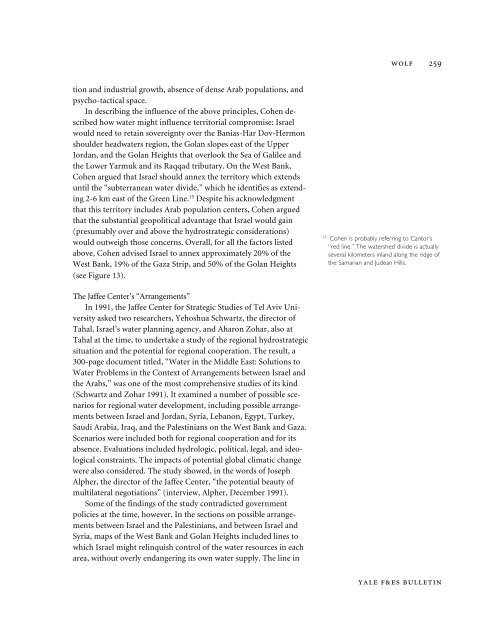Hydrostrategic Decisionmaking and the Arab ... - Yale University
Hydrostrategic Decisionmaking and the Arab ... - Yale University
Hydrostrategic Decisionmaking and the Arab ... - Yale University
Create successful ePaper yourself
Turn your PDF publications into a flip-book with our unique Google optimized e-Paper software.
WOLF 259tion <strong>and</strong> industrial growth, absence of dense <strong>Arab</strong> populations, <strong>and</strong>psycho-tactical space.In describing <strong>the</strong> influence of <strong>the</strong> above principles, Cohen describedhow water might influence territorial compromise: Israelwould need to retain sovereignty over <strong>the</strong> Banias-Har Dov-Hermonshoulder headwaters region, <strong>the</strong> Golan slopes east of <strong>the</strong> UpperJordan, <strong>and</strong> <strong>the</strong> Golan Heights that overlook <strong>the</strong> Sea of Galilee <strong>and</strong><strong>the</strong> Lower Yarmuk <strong>and</strong> its Raqqad tributary. On <strong>the</strong> West Bank,Cohen argued that Israel should annex <strong>the</strong> territory which extendsuntil <strong>the</strong> “subterranean water divide,” which he identifies as extending2-6 km east of <strong>the</strong> Green Line. 15 Despite his acknowledgmentthat this territory includes <strong>Arab</strong> population centers, Cohen arguedthat <strong>the</strong> substantial geopolitical advantage that Israel would gain(presumably over <strong>and</strong> above <strong>the</strong> hydrostrategic considerations)would outweigh those concerns. Overall, for all <strong>the</strong> factors listedabove, Cohen advised Israel to annex approximately 20% of <strong>the</strong>West Bank, 19% of <strong>the</strong> Gaza Strip, <strong>and</strong> 50% of <strong>the</strong> Golan Heights(see Figure 13).15Cohen is probably referring to Cantor’s“red line.” The watershed divide is actuallyseveral kilometers inl<strong>and</strong> along <strong>the</strong> ridge of<strong>the</strong> Samarian <strong>and</strong> Judean Hills.The Jaffee Center’s “Arrangements”In 1991, <strong>the</strong> Jaffee Center for Strategic Studies of Tel Aviv <strong>University</strong>asked two researchers, Yehoshua Schwartz, <strong>the</strong> director ofTahal, Israel’s water planning agency, <strong>and</strong> Aharon Zohar, also atTahal at <strong>the</strong> time, to undertake a study of <strong>the</strong> regional hydrostrategicsituation <strong>and</strong> <strong>the</strong> potential for regional cooperation. The result, a300-page document titled, “Water in <strong>the</strong> Middle East: Solutions toWater Problems in <strong>the</strong> Context of Arrangements between Israel <strong>and</strong><strong>the</strong> <strong>Arab</strong>s,” was one of <strong>the</strong> most comprehensive studies of its kind(Schwartz <strong>and</strong> Zohar 1991). It examined a number of possible scenariosfor regional water development, including possible arrangementsbetween Israel <strong>and</strong> Jordan, Syria, Lebanon, Egypt, Turkey,Saudi <strong>Arab</strong>ia, Iraq, <strong>and</strong> <strong>the</strong> Palestinians on <strong>the</strong> West Bank <strong>and</strong> Gaza.Scenarios were included both for regional cooperation <strong>and</strong> for itsabsence. Evaluations included hydrologic, political, legal, <strong>and</strong> ideologicalconstraints. The impacts of potential global climatic changewere also considered. The study showed, in <strong>the</strong> words of JosephAlpher, <strong>the</strong> director of <strong>the</strong> Jaffee Center, “<strong>the</strong> potential beauty ofmultilateral negotiations” (interview, Alpher, December 1991).Some of <strong>the</strong> findings of <strong>the</strong> study contradicted governmentpolicies at <strong>the</strong> time, however. In <strong>the</strong> sections on possible arrangementsbetween Israel <strong>and</strong> <strong>the</strong> Palestinians, <strong>and</strong> between Israel <strong>and</strong>Syria, maps of <strong>the</strong> West Bank <strong>and</strong> Golan Heights included lines towhich Israel might relinquish control of <strong>the</strong> water resources in eacharea, without overly endangering its own water supply. The line inYALE F&ES BULLETIN
















